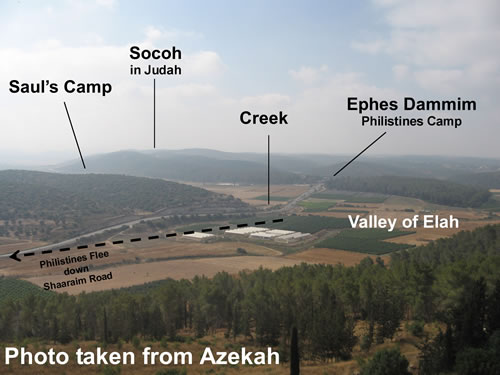
The exact location of David’s battle with Goliath and Israel’s route of the
Philistines back into Philistia

| Bible School Home Page | Textbook - Framework for Christian Faith .pdf | generationword.com home page |
|---|
| Written | Online Audio or Video |
|
|---|---|---|
Written Notes Maps: Photos: |
2009 mp3 Audios- Real Player Videos - |
Chapter Tests: Sect D, Ch 21 - Kings of Judah Essay Tests: |
David, Israel and Judah, the Kings, Babylonian Captivity
Before Samuel died he was told to anoint a new king. This king was from Bethlehem and a son of Jesse who himself was a descendent of:
Jesse’s son David is anointed in a private ceremony in the home of Jesse in Bethlehem. David is a young shepherd boy who one day delivers food for his older brothers who are serving in Saul’s army. David ends up on the front of the battle line drawn up between the Philistines and Israel. As Saul and his army are paralyzed with fear David responds to the Philistine’s champion Goliath’s threats and goes out to meet him in a duel. David sinks one stone into the Philistine giants forehead to kill him and Israel’s army responds by routing the Philistines out of Israel and back into Philistine territory.

The exact location of David’s battle with Goliath and Israel’s route of the
Philistines back into Philistia
The young David is placed in Saul’s army and soon ranks as a general. The Philistine problem is neutralized by David’s bravery and brilliance. Saul becomes jealous and considers David a threat to his royal throne and dynasty. The result is that David spends the next 14 years as a fugitive fleeing from Saul.
In 1010 Saul is killed in battle against the Philistines on Mt. Gilboa. David is asked to return to his tribe and serve as the king of Judah in the city of Hebron. The other eleven tribes are still devastated from the Philistine invasion and have Ish-Bosheth, the surviving son of Saul, in place as their king. David reigned in Hebron as king of Judah for 7 ½ years. After the assassination of Ish-Bosheth the other eleven tribes of Israel came to David and gave him their kingdom. David’s first move was to conquer the never defeated Jebusite stronghold, the fortress city of Jerusalem. From this new centralized capital, on the southern side of Mt. Moriah where Abraham had offered Isaac, David established the kingdom of the unified Israel and reigned from Jerusalem for the next 33 years (2 Samuel 5:3-5; 5:6-10). David will reign for a total of 40 years (1010-970 BC).
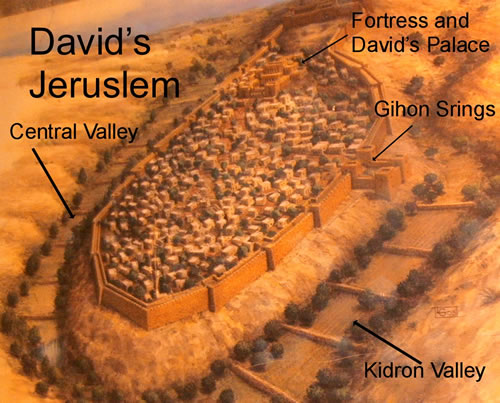
The city of Jerusalem that David took and built up.

The sloping Jebusite walls of the ancient city of Jerusalem located on the east side north of the Gihon Springs just outside the fortress that David built. (In the background the straighter, vertical wall is the remains of the wal built by Nehemiah.)
David decisively defeated the Philistines and eliminated them as a threat to Israel forever. The unconquered Canaanite cities such as Beth Shan, Megiddo and Dor were subdued. Politically David secured and expanded the borders of Israel to include the Moabites, Arameans, Edomites, and Ammonites. David established international relationships with Hiram, king of the Phoenicians.
Concerning the area of spiritual worship David advanced YHWH worship by:
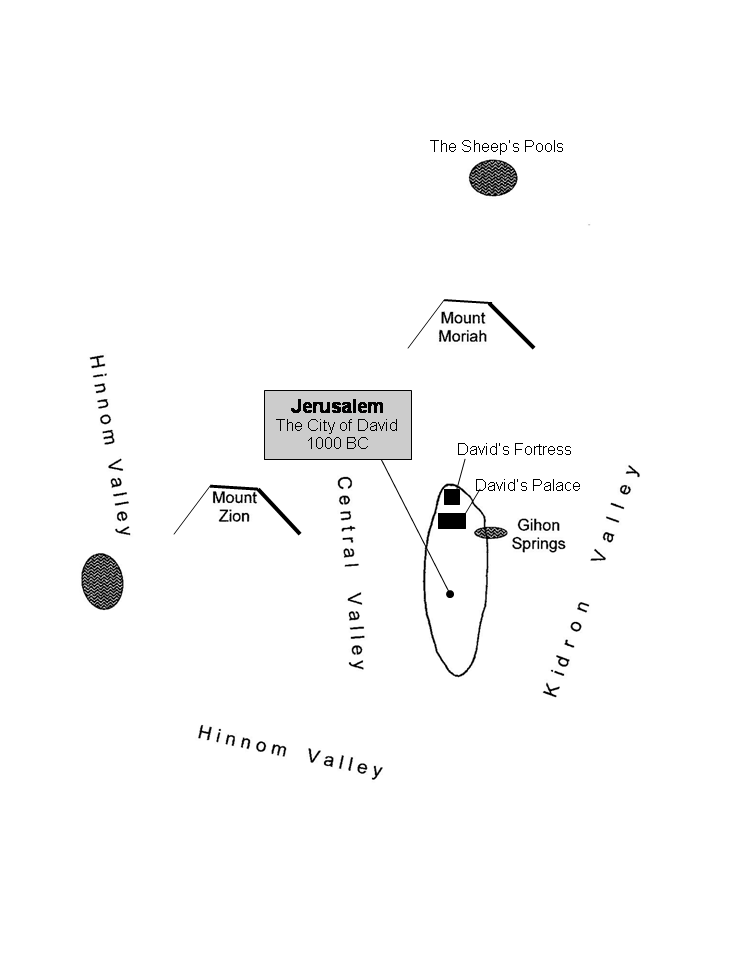
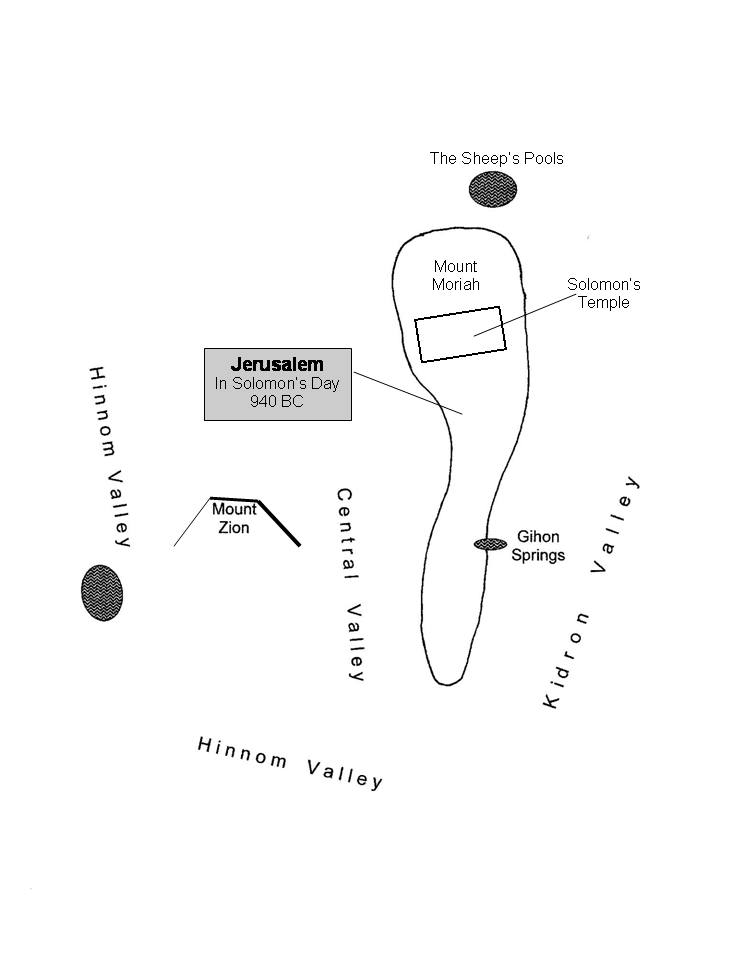
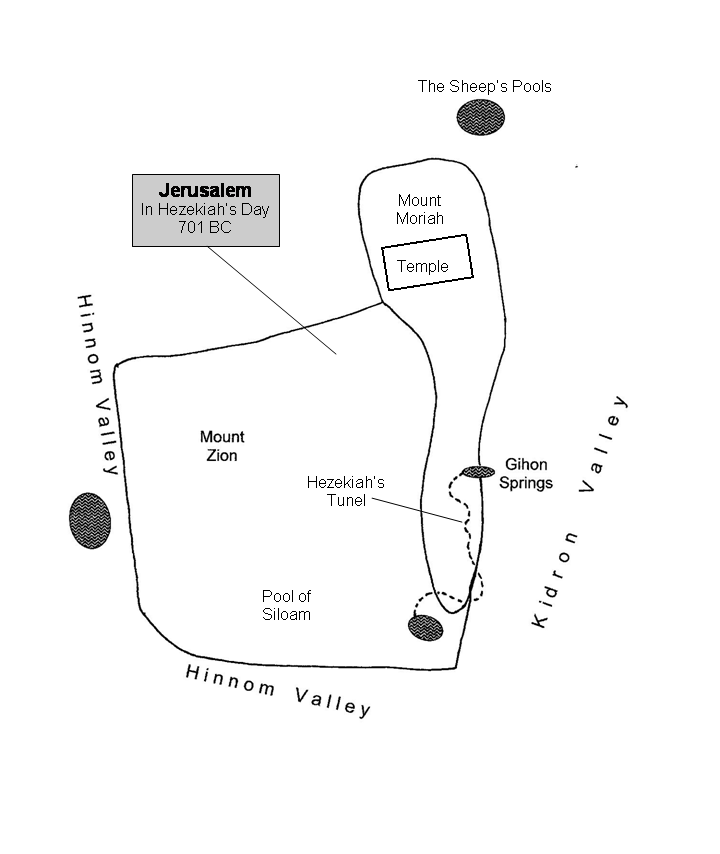
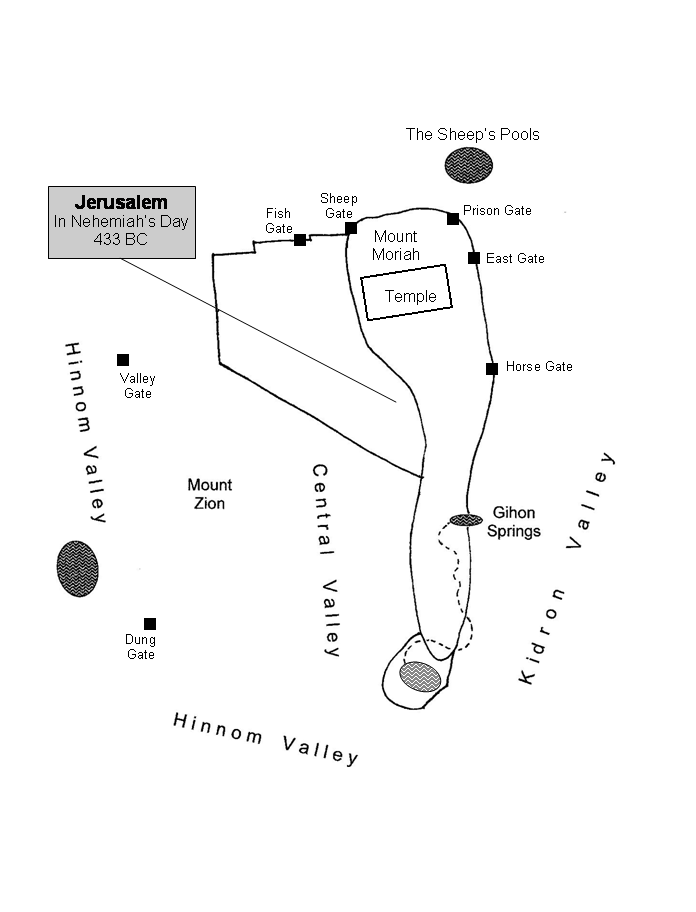
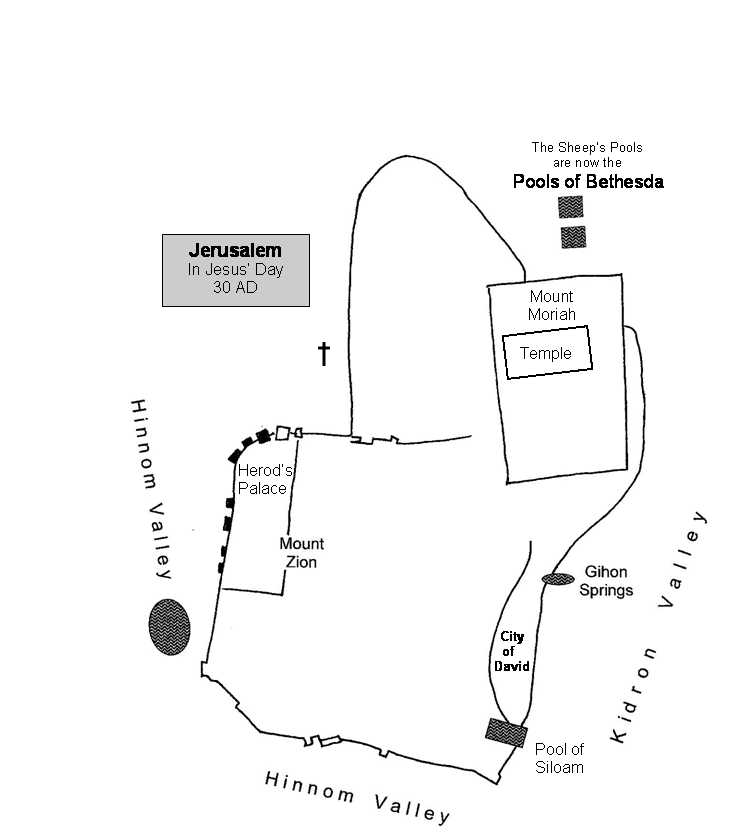
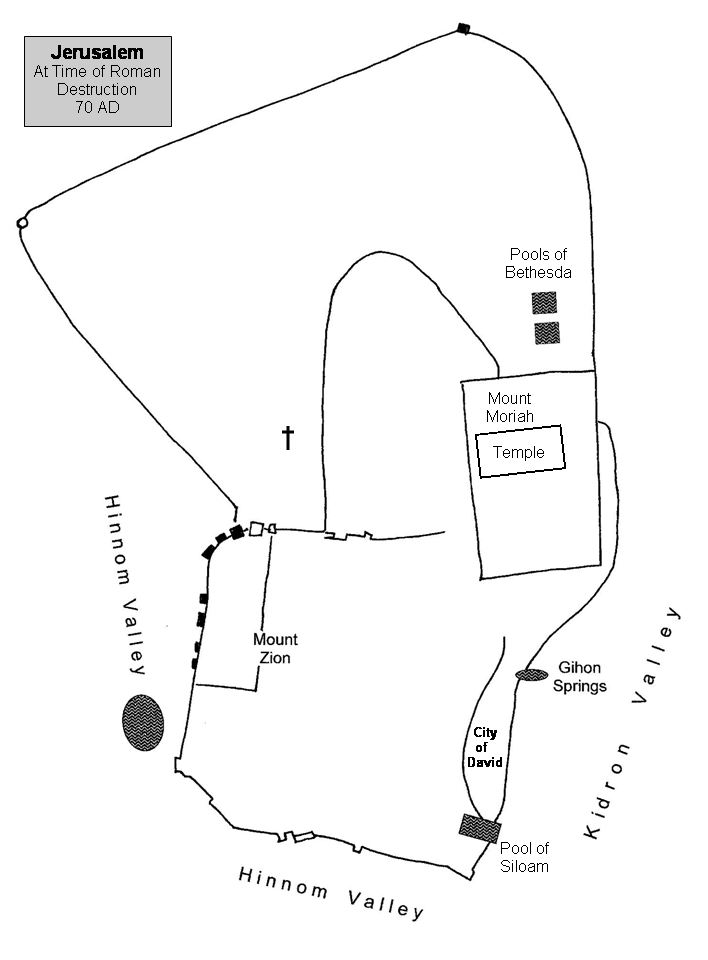
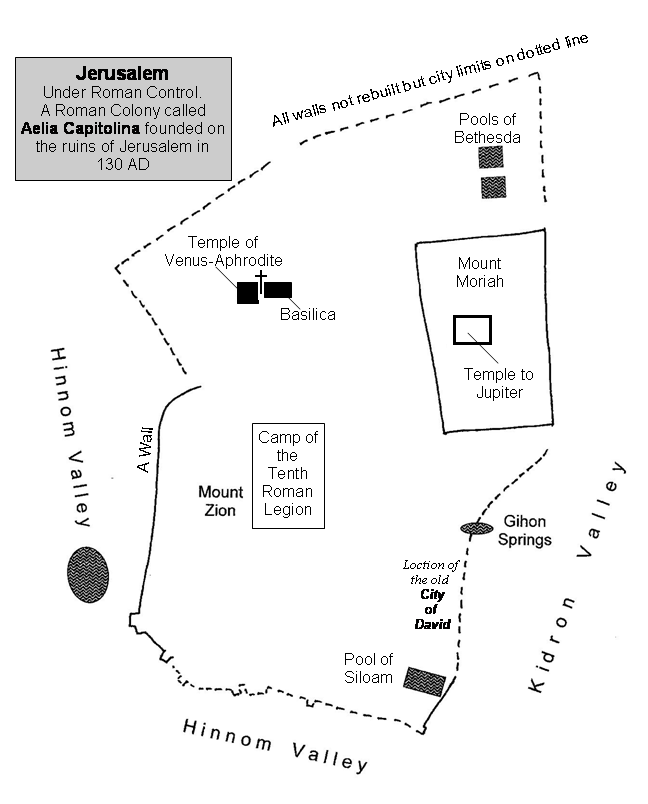
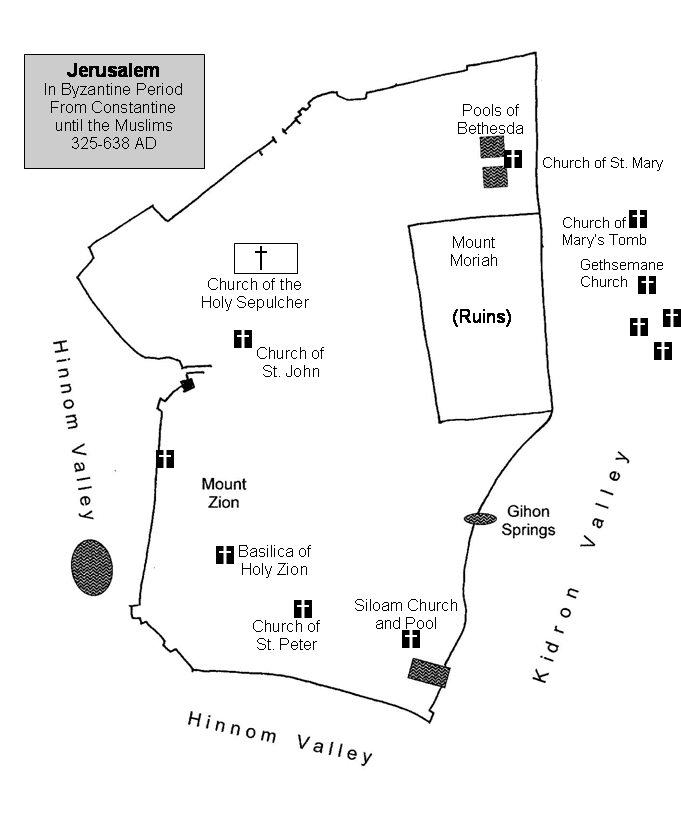
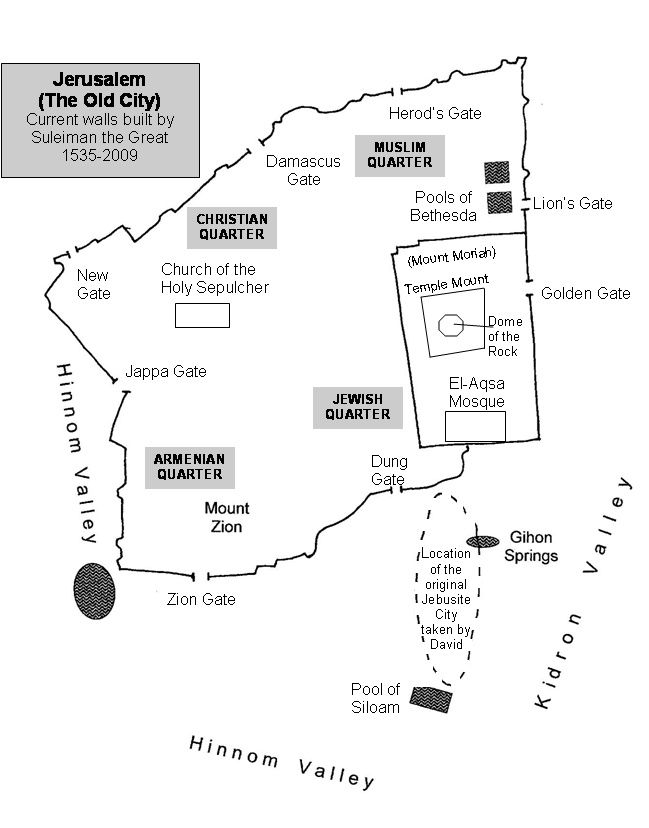
David also faced many struggles in his life including an adulterous relationship with Bathsheba, murder and rape among his children and a revolt by his son Absalom which led to a civil war. At the end of his life David angered God by counting his fighting men and brought a three day plague on the land that killed 70,000 people. (2 Samuel 24:11-16)
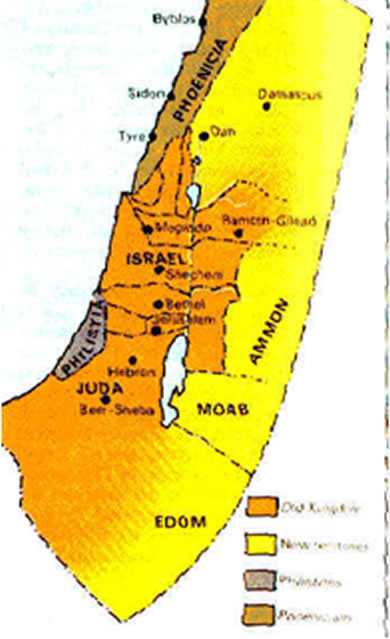
David died leaving the strong, peaceful, prosperous kingdom to his son Solomon. Solomon’s first line of action, based on advice from his father, was to kill or confine his major political enemies including the high priest Abiathar, David’s general Joab, and Shimei from the house of Saul who had cursed David when he fled from Absalom.
During the first days of his reign, Solomon (970-930 BC) went to the high place in Gibeon to offer sacrifices at the tabernacle of Moses. Here God appeared to Solomon in a night vision and Solomon asked for wisdom to govern the people of God, the chosen nation of Abraham. Solomon’s wisdom and prosperity is unsurpassed.
Solomon built the temple in Jerusalem on the location north of the City of David. The addition of the temple mount area to the city of Jerusalem added 32 acres to the previous 10 acres of the City of David
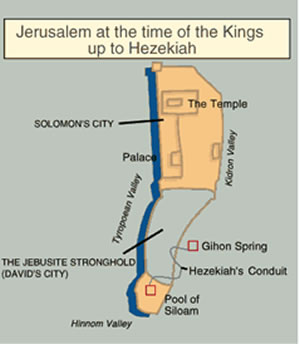

A model of the temple in 70 AD built by Herod.
During the first twenty years of his reign (970-950) Solomon built the temple and his palace. By 950 BC Solomon was rebuked by the King of Hiram for not paying his debt for Phoenician laborers and building materials. Solomon also built ships and sailed south into the Red Sea in search of gold to help pay for his many building projects. Solomon’s plans to build wealth were a huge success as recorded in 1 Kings 9 and 10.
Solomon’s downfall is caused by the many foreign wives he married: Moabite, Ammonite, Edomite, Sidonian, Hittite. The wives of royal birth brought into Jerusalem their pagan religions and false philosophies which misled Solomon (1 Kings 11:1-9). The Lord was angered and adversaries rose up against Solomon including Jeroboam one of Solomon’s best craftsman who was in charge of Solomon’s labor force. Solomon’s confused state during the last years of his life can be found recorded in the book of Ecclesiastes.
When Solomon died in 930 BC, his son, Rehoboam was to be king of the united twelve tribes of Israel as David and Solomon had been. Jeroboam rose up against Rehoboam asking for freedom from the harsh labor and heavy taxes placed on the people of Israel by Solomon. Rehoboam rejected Jeroboam’s request and threatened the people of Israel’s with harder labor and more sever taxation (2 Kings 12). Israel replied,
“What share do we have in David . . . To your tents, O Israel! Look after your own house, O David!” (2 Kings 12:16)
With this the united kingdom of Israel faced a brief civil war which was ended by a prophet telling the tribes to go home because this break up of the nation was the Lord’s doing (2 Kings 12:24)
Jeroboam’s first official act was to rewrite Israel’s history and set up new gods, two golden calves in Bethel and Dan. The tribes that rebelled against the dynasty of David were the northern tribes of: Asher, Naphtali, Zebulun, Isachar, Manasseh, Gad, Ephraim, Dan, Reuben. The tribes that remained with the line of David were: Judah, Benjamin, and Simeon. The northern tribes were known as the Kingdom of Israel and the southern tribes were known as the Kingdom of Judah.
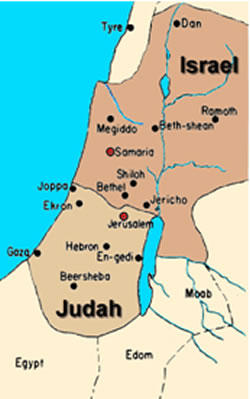
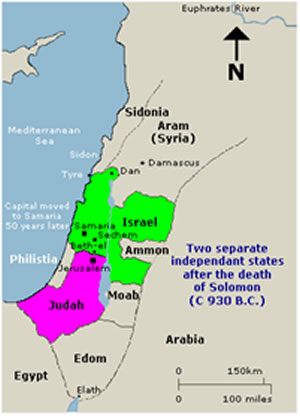
Kings of Israel
Between the years of 930 – 721 the Kingdom of Israel had twenty kings from nine dynasties. They saw six assassinations and two coup d’etat to bring in the new dynasty. Only half of the kings of Israel inherited the throne from their father:
King in Israel |
Length of Reign |
Years of Reign |
Jeroboam |
22 years |
930-909 |
Nadab |
2 years |
909-908 |
Baasha |
24 years |
908-886 |
Elah |
2 years |
886-885 |
Zimri |
7 days |
885 |
Tibni |
5 years |
885-880 |
Omri |
11 years |
885-874 |
Ahab |
22 years |
874-853 |
Ahaziah |
2 years |
853-852 |
Joram |
11 years |
852-841 |
Jehu |
28 years |
841-814 |
Jehoahaz |
17 years |
814-798 |
Jehoash |
16 years |
798-782 |
Jeroboam II |
41 years |
793-753 |
Zechariah |
6 months |
753 |
Shallum |
1 month |
752 |
Menahem |
10 years |
752-742 |
Pekahiah |
2 years |
742-740 |
Pekah |
20 years |
740-732 |
Hoshea |
9 years |
731-721 |
Assyria invades Israel and captures Samaria after 3 year |
||
After Jeroboam died his son became king but was assassinated after only two years by Baasha of the tribe of Issachar during an Israel siege in Philistia. Jeroboam’s whole family was put to death ending the first dynasty of Israel after twenty-two years.
Baasha reigned in the capital city of Tirzah in Israel but God was not pleased and sent a prophet to pronounce judgment against him saying birds of the air will consume him and his family.
Baasha’s son Elah reigned next in Tirzah for only two years before he was cut down by Zimri while getting drunk at a friends house. Zimri immediately killed the whole family of Baasha according to the prophecy to end the second dynasty in the nation’s short 45 year history.
Zimri had the honor of having the shortest reign. The Israelite army was at war with the Philistines when they heard that Zimri had assassinated their king Elah back in the capital of Tirzah. The military immediately declared their General Omri king of Israel instead of Zimri and turned their ranks from the Philistines to their own capital of Tirzah. When Zimri realized the city had fallen to General Omri’s troops he set the royal palace on fire with himself inside.
These events set up civil war within the nation of Israel between the military king, General Omri, and the people’s king, a man known only as Tibni son of Ginath. As would be assumed the military won the civil war and Omri begins the fourth dynasty after four years of battle. This dynasty will last 44 years, the second longest in northern Israel’s 200 year history.
After rebuilding and reigning for six years in the burnt out capital of Tirzah, Omri bought the hill of Samaria eight miles to the west for 150 pounds of silver and built a new capital city on it called Samaria. Omri had a son he named Ahab who became one of Israel’s most notorious kings. Omri’s dynasty placed four kings on the throne of Israel and also married a royal daughter into the line of David’s in Judah.
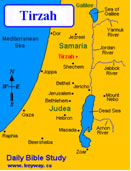
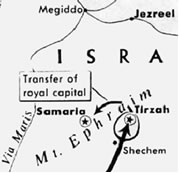
Ahab, Omri’s son, became king in 874 BC. All the kings of Israel were called evil and most are described as walking in the ways of their original king Jeroboam. Ahab considered these sins trivial and increased the evil of Israel by marrying the Phoenician princess Jezebel, daughter of King Ethbaal.
Under the influence of Queen Jezebel, Ahab and Israel began to serve and worship Baal. Ahab built a temple in the city of Samaria for Baal and set up an altar. Ahab also set up a Asherah pole. The worship of Baal was a Canaanite practice that followed the seasons and focused on productivity of crops and the fertility of the people. Baal was the god of the storm. Since fresh rain water was a necessity for the success of agriculture and the survival of a community Israel followed the Canaanites into Baal worship. According to Canaanite theology, Baal could be awakened and empowered in his struggle against the opposing forces through rituals which included sacred prostitution. The Israelites were swayed by the influence of Baal worshippers to minimize their Lord YHWH as the God certain powers that might include things like war, or the wilderness, but they could easily make room for the god such as Baal who could bring rain and productivity. Asherah was the female consort of Baal. She was represented by a carved pole or tree trunk that was often draped with material and set up near the altar of Baal.
It is into this religious deterioration that God sent one of the most enigmatic prophets of history. Elijah left his village of Tshibe on the other side of the Jordan in the land of Gilead and crossed into the land of Israel and proceeded into Ahab’s palace in Samaria and said:
“As the Lord, the God of Israel, lives, whom I serve, there will be neither dew
nor rain in the next few years except at my word.” (1 Kings 17:1)
This, of course, seemed like a ridiculous statement to the faithful followers of Baal and it was dismissed as ludicrous. But, after three years of no rain, the Baal crowd was in a panic as the whole country searched for Elijah and Ahab offered rewards for his capture.
Elijah eventually meets Ahab and all of his Baal prophets on Mt. Carmel for a dramatic show down between the rain god, Baal, and the Lord God, YHWH. The prophets of Baal and Elijah each build an altar to their God with all the crowd of Israelites watching. After hours of crying out to Baal and attempting to get his attention through self mutilation the prophets of Baal can not physically continue. Elijah turns from mocking them to praying and asking the Lord to answer by sending fire to his altar. God responds with a glorious demonstration of power for the Baal infested audience. Elijah slays the prophets of Baal and then for good measure turns to pray for rain. God answers by sending an enormous rain storm (1 Kings 18:16-19:13).
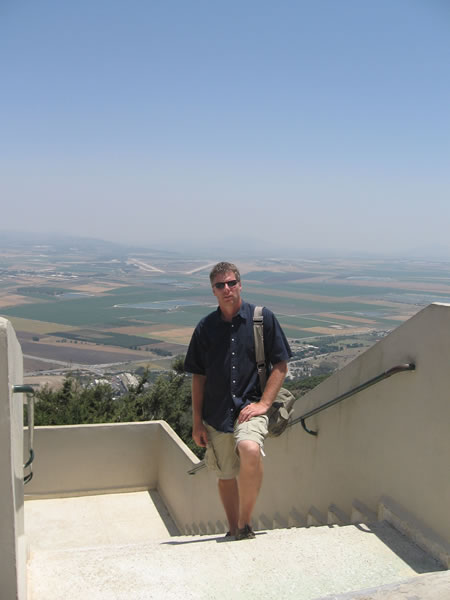
Galyn standing on Mt. Carmel near the location of Elijah's altar with the Valley of Armageddon in the back ground and the Israeli Air force landing strip ("V" shape) over his right shoulder.
Queen Jezebel’s only response is to threaten Elijah with decapitation. Elijah flees to Mt. Sinai to talk to God and feel sorry for himself. God is not impressed with Elijah’s self-pity and sends him back to do three final things in his ministry (1 Kings 19:15-18):
Ben-Hadad, invaded Israel and besieged King Ahab at Samaria. Ben-Hadad demanded that all Ahab’s gold, silver, wives and children be sent out to him. Ahab did but Ben-Hadad then demanded that he would come into the city and take whatever he wanted. Ahab was dismayed but the Lord sent a prophet to tell him that if Ahab attacked he would win. Ahab listened to the prophets advice and won the battle. But when Ahab captured Ben-Hadad he allowed him to live in exchange for a place in the Aramian market in Damascus. The Lord was not pleased and sent the prophet to rebuke Ahab by saying:
“You have set free a man I had determined should die. Therefore it is your life for his life, your people for his people.” (1 Kings 21:42)
Three years later (1 Kings 22:1), before the next battle against Aram God calls a counsel of angels and spirits to determine how Ahab will die. Second Chronicles records this heavenly counsel in chapter 18. A demonic spirit offers to be a lying spirit in the mouths of the false prophets Ahab has surrounded himself with. Ahab follows that false advice and is hit with a random arrow before the battle even begins at Ramoth Gilead.
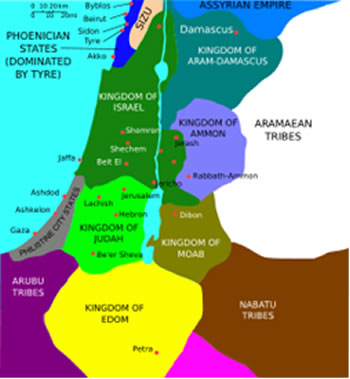
Ahab’s son, Ahaziah, reigns for two years. With the death of Ahab, Moab rebels against Israel’s dominion giving Ahaziah two battle fronts to face. Mesha, king of Moab, had supplied Israel with lambs and wool during Ahab’s reign (2 Kings 3:4).
King Ahaziah fell through some lattice in his upper room in the palace of Samaria and was seriously injured. From his bed he sends men to the land of Philistia to the city of Ekron to inquire of one of their local deities, Baal-Zebub. His men are intercepted by Elijah who sends back a message saying that Ahaziah will die in his bed. Twice Ahaziah sends out fifty men to arrest Elijah who simply calls fire out of heaven to consume them. A third group begs for mercy and Elijah goes with them with them but gives the same message: “You will never leave the bed you are lying on.” Ahaziah died and his brother Joram succeeded him.
At this time, 852 BC, Elijah is taken into heaven with a chariot of fire (2 Kings 2). Elisha takes over Elijah’s ministry which has not yet anointed the next king of Aram nor the next king of Israel.
During Joram’s reign, the Moabite revolt became more severe and Israel had to mobilize their troops along with troops from the kingdom of Judah and Edom. Elisha was with the Israelite troops and after seven days the troops are without water. Because of the presence of King Jehoshaphat of Judah from the line of David, Elisha agrees to inquire of the Lord. A harpist is asked to play music and soon the Lord speaks through Elisha and says to fill the valley with trenches. By the next morning the trenches were full of water for the troops of Israel, Judah and Edom to drink. But, to the Moabites, the reflection of the morning sun made the trenches of water look like blood from a battle between Israel, Judah and Edom. Moab came to the camp of Israel and where routed back into the land of Moab. The Israelites left the battle when they saw Mesha sacrificed his own son. With this Israel withdrew from the battle and Mesha claimed victory. (2 Kings 3:27)
Interestingly, King Mesha of Moab also records this rebellion on what is known as the Moabite Stone. It was discovered in the ancient land of Moab 20 miles east of the Dead Sea. Today it is in the Louvre Museum in Paris, France. It is a bluish basalt stone, 4 feet high and 2 feet wide,14 inches thick, with an inscription from king Mesha that reads:
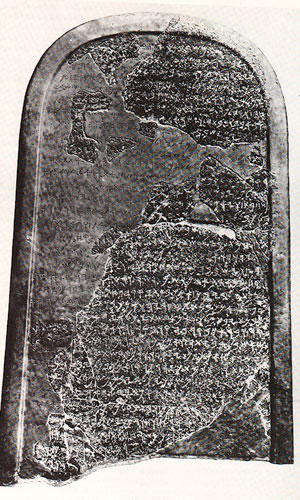 The Moabite Stone
The Moabite Stone
The Moabite Stone is important for several reasons:
During the days of King Joram (852-841) Elisha does several miracles that are recorded in scripture:
Around 845 Ben Hadad of Aram besieged Samaria and caused a famine in the city so great that a donkey’s head sold for 2 pounds of silver and ½ a pint of dove dung sold for 2 ounces of silver. People were eating their children (2 Kings 6:28,29). Elisha prophesied to King Joram that with in 24 hours the siege would be lifted. The Lord then caused the sound of chariots, horses and a great army to scare the Aramean army into thinking the Egyptians was coming to help Israel. The Aramens fled their camp leaving all of their supplies behind and abandoning the siege of Samaria. The next day some men with leprosy went out to the Aramean camp only to discover it abandoned. The next day the supplies of the Aramean soldiers were being distributed in the city of Samaria.
Elijah had established schools of the prophets in Gilgal, Bethel and Jericho. In 841 Elisha sent one of these prophets (Jewish scholars teach it was young Jonah) across the Jordan to Ramoth Gilead to anoint the Israel General Jehu to be the next king. Jehu been stationed in Ramoth Gilead to defend it from being taken by Hazael the new king of Aram. Jehu drove his chariot towards Jezreel to find King Joram. When Joram rode out to meet him Jehu shot him with an arrow.Jehu continued into the city of Jezreel where Joram’s mother, Queen Jezebel, was staying. When she came to the window two or three of her servants threw her out the window and she was run over by the chariot and eaten by dogs. Jehu then sent letters to Samaria to the leaders of the city who cut off the heads of the seventy sons of Ahab and had them sent to Jehu in Jezreel. Jehu then deceived the prophets of Baal by claiming to want all of them to join together to worship with him at Baal temple. When they were all assembled Jehu had them all killed. Jehu destroyed Baal worship in Israel and the Lord promised that Jehu would have four generations sit on the throne of Israel. The year was 841 and Jehu’s dynasty, the fifth of the Kingdom of Israel, would rule for 89 years until 814.
Jehu reigned for 28 years and then his son Jehoahaz began his 17 year reign in 814. The Lord was not pleased with Jehoahaz and the power of King Hazael and his son Ben Hadad II of Aram increased and oppressed Israel. When Jehoahaz sought God a deliverer was provided but the Asherah pole was left standing in Samaria. King Hazael of Aram had destroyed the army of Israel by threshing them into dust (See Amos 1:3 for God’s judgment on Aram) and left them with only 50 horseman, 10 chariots and 10,000 soldiers.
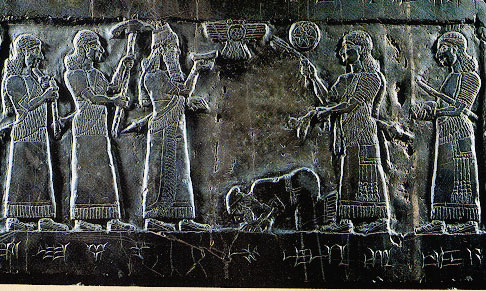
Jehu went to Shalmaneser and paid him tribute for peace, trade and military
support. Above is an Assyrian relief of Jehu on his knees before Shalmaneser.
Jehoash followed his father as King of Israel. He was the third generation of Jehu’s dynasty. Jehoash reigned 16 evil years in Israel. One day Jehoash went down to visit Elisha who was an old man and “was suffering from the illness from which he died.” (2 Kings 13:14) Elisha had Jehoash shoot an arrow out the window. When Jehoash obeyed Elisha proclaimed, “The Lord’s arrow of victory. . .You will compleely destroy the Arameans at Aphek.” Then Elisha told King Jehoash to take some arrows and strike the ground. Jehoash struck the ground three times and stopped. Elisha was angry with him and said, “You should have struck the ground five or six times. . .now you will defeat Aram only three times.”
Elisha died. Hazael, king of Aram died and his son Ben Hadad II began to reign. Jehoash defeated Aram three times and recovered the towns of Israel.
Zechariah, the fifth generation of Jehu’s dynasty, replaced his father Jeroboam II and reigned only six months. Shallum attacked and killed Zechariah at a public gathering.
Shallum then reigned one month in Samaria and then Menahem from Tirzah attacked and killed him.
Menahem faced a new threat coming from the north of the now subdued Aram. The Assyrians led by King Tiglath-Pileser III (Pul in the NIV) invaded the land. Menahem gave him 37 tons of silver to guarantee his position on the throne. This political expense was passed on to the people as a 1 ¼ pound tax of silver. Menahem reigned for ten years and died in 742.
Pekahiah, son of Menahem, reigned for two years. One of his officers, Pekah, son of Remaliah, took fifty men into the most secure part of the palace, the royal citadel, and killed Pekahiah.
Pekah, son of Remaliah, (mentioned in Isaiah 7:4-10) lost several of his northern cities to Tiglath-Pileser, King of Assyria. After twenty years Pekah was assassinated by Hoshea who replaced him as king.
Hoshea began reigning in 731. He was a vassal king for the rising Assyrian empire. The new Assyrian king, Shalmaneser, discovered that Hoshea had sent ambassadors to So the king of Egypt. When Hoshea stopped paying tribute Shalmaneser put him in prision in 724. Shalmaneser then invaded the land of Israel and led a three year Assyrian siege against Samaria.
In 721 the Assyrians captured Samaria and deported the Israelites of Israel into Assyria and dispersed them throughout the Assyrian Empire.
The Seven Great Empires of the Ancient World
ASSYRIAN EMPIRE: Background and History |
||
Assyria was one of the ancient kingdoms of Mesopotamia with natural and political boundaries being the Syrian desert to the west, the kingdom of Babylon to the south and hills of Armenia and Persia to the north and the east. Existence in Assyria depended on the Tigris and Euphrates rivers. Genesis 10 (2350 BC) records Nimrod extended his kingdom from Babylonia to build the great cities of Assyria: Nineveh, Calah and Resen. Sargon is said to have built Nineveh around 2350 BC and inscriptions of Amar-Su’en from Ur in Babylonia have been found in Ashur. Assyria established trade colonies in Anatolia (Turkey) where they exchanged tin and textiles for silver. Around 1775 the kingdom of Hammurabi of Babylonia included Assyria. His dynasty maintained control for the next five generations. Pharaoh Amenhotep (1360 BC) mentions the great powers of his time to include Egypt, the Hittites, Babylonia and Assyria. Ashur-uballit I reigned at this time and was followed by three notable kings Adad-nirari I (1308-1275), Shalmaneser I (1275-1245) and Tukulti-Ninurta I (1245-1208). From 1116-1076 Tiglath-pileser I expanded the empire for the first time to include the Mediterranean coast of Syria. A decline in the Assyrian empire followed and the Aramean (Syria) kingdom began to rise as seen in the Old Testament account of Ahab’s life in 1 Kings (874-853). The kingdom of Aram lay between Israel and the Assyrians. In the days of Shalmaneser III (859-824) Israel’s king Ahab is recorded in Assyrian annals as being in league with Aramian king Ben Hadad in a coalition of ten kings against the rising Assyrian empire. Ahab is listed as supplying 2,000 chariots and 14,000 men for a battle at Qarqar in 853. This is the same year Ahab dies in battle trying to regain Ramoth Gilead from the Aramians after three years of peace (1 Kings 22:1, 27, 37). After the death of Ahab and Ben Hadad, Damascus finally fell to the Assyrians. Shalmaneser III records on a black obelisk an image of Jehu, king of Israel (841-814) kneeling with his face to the ground before Assyrian king Shalmaneser paying tribute. By going to Shalmaneser, Jehu broke alliance with kingdom’s such as Judah, Aram and others to side with and gain support from Assyria. This black obelisk was erected as a public monument in 825 BC during a civil unrest in the final days of Shalmaneser.
In 804 Assyrian king Adad-nirari attacked Hazael in Damascus making it possible for Joash to recover Israel towns from Aram’s control (2 Kings 12:17; 2 Chron. 24:23) Jeroboam II (793-753) was able to expand Israel’s border all the way to Hamath (2 Kings 14:25-28) because Shalmaneser IV (781-772) was not the royal son and ruled with internal dissension leading to a weaker empire. Assyria was struck with a plague in 765. In 763 while Jeroboam II was still king, Asshur-Dan III was defeated by invaders coming from the north who drove Assyria back to within 100 miles of Nineveh. This occurred simultaneously with an eclipse of the sun documented in Assyrian annuals and in computer generated astrological patterns. Another plague in 759 set the stage for the prophet Jonah (a student of Elisha, and the prophet who anointed Jehu as king of Israel) to preach in Nineveh in 759. In 745 Tiglath-pileser III (or, Pul) began to expand Assyrian borders to include the Persian Gulf, Armenian mountains, Aram (Syria) and Palestine. The captives are all deported and dispersed throughout the empire. In 734 Tiglath-pileser moved west and plundered Phoenican cities on the coast and the Philistines cities of Ashkelon and Gaza. Rezin of Damascus, Ahaz of Judah, Ammon, Edom and Moab all paid tribute (2 Chon. 28:19-21). Tiglath-pileser III took Israel and replaced king Pekah with his own choice of King Hoshea. Although the prophet Isaiah warned Ahaz (Isaiah 7) not to, Ahaz paid Tiglath-pileser III to help Ahaz against Israel, Rezin of Damascus (Aram), Edom and Philistia. Shalmaneser V (727-722) continued the same practices of invasion, domination and deportation. When Israel’s king Hoshea trusted Egypt and withheld his tribute to Assyria, Shalmaneser took Israel in 725 and laid siege to Samaria. In 722 Samaria fell to Shalmaneser’s successor, Sargon II (722-205) and reports that 27,000 people were deported from Samaria. Sargon began the last dynasty of Assyrian kings that included: Sargon, Sennacherib, Esarhaddon, Ashurbanipal. Sargon received tribute from Hezekiah of Judah but defeated Egypt along with Philistine towns of Ashdod and Gath. As Judah looked to Egypt or Babylon for help Isaiah continued to speak to Judah and help kings like Hezekiah. Sennacherib (705-681) had to suppress a revolt by Merodach-baladan (Marduk-apal-iddina) in Babylonia in 703 that Isaiah had rebuked Hezekiah for getting involved with (2 Kings 20:2-19; Isaiah 21, 38, 39). Sennacherib left Babylonia and marched into Syria and Palestine in 701 taking Sidon, Ashkelon and Lachish. When Sennacherib was approaching Jerusalem after the fall of Lachish the Assyrian army suddenly withdrew and return to Assyria. Herodotus, Isaiah and 2 Kings records this sudden retreat of Sennacherib from Judah. In 689 Sennacherib’s forces defeated Babylon but in 681 Sennacherib was murdered by his sons. Esarhaddon (681-669), another son, became king only to face problems in the north with the Cimmerians and the Scythians. In the south Egyptian king, Tirhakah, and Judah’s king, Manasseh, rebelled and didn’t pay their tribute which Esarhaddon needed in order to secure the north. This led to Manasseh being led into Babylon with a ring in his nose and held captive for a couple of years (2 Chron. 33:11). In 672 Egypt was defeated. Esarhaddon placed his son Sha-mash-shum-ukin crown prince of Babylonin and Ashurbanipal as crown prince of Assyria. This arrangement lasted for 12 years after the death of Esarhaddon, but in 651 Ashurbanipal invaded his brother’s kingdom in Babylon. Kandalanu was seated by the Assyrians as the governor of Babylonia. When Kandalanu died in 627 a Babyonian (Chaldaean) chieftain, Nabopolasar, organized the Chaldaean tribes and in 626 drove the Assyrians out of Babylon. The Assyrians at this time were torn by internal fighting and rebellion. Nabopolasar’s son, Nebuchadrezzar led the Babylonians in several campaigns and defeated the Egyptians at Carchemish in 605 when they came to help the falling Assyrians. |
Kings of Judah
When Solomon died in 930 BC his son Rehoboam became king of the united kingdom of the twelve tribes at the age of forty-one. When Rehoboam rejected the northern tribes request for lower taxation and less required labor the kingdom suffered a split. Solomon’s son was left with the tribe of Judah and Benjamin which included the city of Jerusalem and the temple. Rehoboam’s mother was an Ammonite and the decline of the nation of Judah continued as high places, Baal stones and Asherah poles were set up. Worship at a high place include worship of YHWH but without the guidance of the priests and the rituals of prescribed in the Law of Moses. Soon these independent worship centers began to reflect the surrounding pagan cultures more than the temple worship. During Rehoboam’s day worship even began to include male shrine prostitutes (1 Kg. 14:14). As a from of judgment God sent Shishak king of Egypt into Jerusalem. In Rehoboam’s fifth year Shishak carried off the temple treasuries, the royal palace treasuries and the gold shields that Solomon had made to hang in the halls of his palace.
King of Judah |
Length of Reign |
Years of Reign |
Rehoboam |
17 years |
930-913 |
Abijam |
3 years |
913-910 |
Asa |
41 years |
910-869 |
Jehoshaphat |
25 years |
872-848 |
Jehoram |
8 years |
853-841 |
Ahaziah |
1 years |
841 |
Athaliah |
7 years |
841-835 |
Joash |
40 years |
835-796 |
Amaziah |
29 years |
796-767 |
Uzziah |
52 years |
792-740 |
Jotham |
16-20 years |
750-735 |
Ahaz |
16-20 years |
735-715 |
Hezekiah |
29 years |
715-686 |
Manasseh |
55 years |
697-642 |
Amon |
2 years |
642-640 |
Josiah |
31 years |
640-609 |
Jehoahaz |
3 months |
609 |
Jehoiakim |
11 years |
609-598 |
Jehoiachin |
3 months |
597 |
Zedekiah |
11 years |
597-586 |
Babylon invaded Judah in 605 & 597. In 586 Jerusalem |
||
Abijah, son of Rehoboam and his wife, idolatrous Maachah of Gibeah, became king and queen while Jerobaom was still king in Israel. Abijah captured Bethel and other towns from Jerobaom.
Asa became king in 910 BC and removed the high places, foreign altars, smashed the Baal stones and cut down the Asherah poles. Asa had peace and prosperity in the land so he built up the fortified cities. Zerah the Cushite, a general from Egypt, marched as far as the road that led to Jerusalem through the foothills of Judah. Asa called on the Lord and defeated him in battle with an army of 300,000 from Judah and 280,000 form Benjamin. Inspired by the prophet Azariah, Asa repaired the temple of the Lord and continued to cleanse the land of idols. He removed his queen mother Maacha from her throne and burnt her Asherah pole in the Kidron Valley east of Jerusalem. Many people from the tribes of Ephriam, Manasseh and Simeon from the Kingdom of Israel moved into Judah during this time. Asa made a treaty with Ben-Hadad of Aram when Baasha, king of Israel, fortified his border with Judah to prevent any more people from leaving Israel and going into Judah. The prophet Hanani rebuked Asa for going to Aram for help. Asa imprisoned the prophet and began to mistreat the people of Judah. Asa was inflicted with a severe foot disease in his 39th year and died in 869 in his 41st year as king of Judah.
Jehoshaphat began to reign with his father in 872. He followed God and stationed troops in the fortified cities and put garrisons in the cities his father had captured. Jehoshaphat sent officials and Levites throughout the land of Judah to teach the Book of the Law. The fear of the Lord fell on the kingdoms around Judah including the Philistines who brought gifts and the Arabs who brought Jehoshaphat 7,000 rams and 7,000 goats. When Ahab, king of Israel, was preparing to go to battle against Aram, Jehoshaphat joined him. Ahab disguised himself as a foot soldier and was killed. Jehoshaphat returned safely to Judah but was rebuked by the prophet Jehu. Jehoshaphat appointed judges from Beersheba to the hill country of Ephraim and turned the people back to the Lord and to administer the law of the Lord. When the Moabites and Ammonites united in war against Judah, Jehoshaphat declared a fast and the people sought the Lord. Jahaziel, a Levite, prophesied that the battle was God’s and there would be deliverance if the people marched out to face the enemy. Jehoshaphat consulted the people then appointed men to march in front of the army and to sing praise to the Lord. The armies of Moab and Ammon turned on each other and Judah carried off plunder for three days. Jehoshaphat followed God all his days except for the time he aligned with Ahaziah of Israel to construct a fleet of trading ships to sail to Tarshish. The prophet Eliezer told him that because he had made an alliance with wicked Ahaziah the ships would never sail. The fleet was destroyed.
Jehoram, Jehoshaphat’s son, had married the Athaliah, the daughter of Ahab and Jezebel from the kingdom of Israel. Jehoram reigned like a king of Israel and not like the kings of Judah. He killed all of his brothers. Edom and Libnah rebelled against Judah at this time and set up their own kings. The prophet Elijah, who was taken by the chariots in 852, had written Jehoram (853-841) a prophetic letter rebuking him for his wickedness. This letter would have been written right after Jehoram had killed his brothers in 853 and right before Elijah died in 852. The letter spoke of a lingering disease of the bowels that would kill Jehoram. The Philistines and Arabs of southern Egypt invaded Judah and carried off the palace treasures and killed all of Jehoram’s sons. Only Ahaziah, the youngest son of Athaliah, was left. Jehoram died of a painful, incurable disease of the bowels at the age of 40. The people of Judah did not honor him at his death.
Ahaziah, the son of Jehoram and Athaliah (Jezebel and Ahab’s daughter), became king at the age of twenty-two. His mother encouraged him to do wrong and the house of Ahab in Israel became his advisers. Ahaziah’s uncle Joram, the king of Israel, was injured when he went to war against Hazael of Aram at Ramoth Gilead. Ahaziah went down to Jezreel with his sons and the royal princes to visit his Uncle Joram while he was recovering from his injuries. It just so happened that while Ahaziah was visiting in the kingdom of Israel in Jezreel the Israel general Jehu was anointed at Ramoth Gilead by the prophet that Elisha had sent over. When Jehu came back across the Jordan to Jezreel he killed king Joram when he came out to meet him in his chariot and Jezebel pushed out a window to her death when Jehu reached Jezreel. Jehu found and killed the sons of Ahaziah and the princes of Judah who were staying in Jezreel with their family from Athaliah’s side. Jehu’s men searched and found Ahaziah. Jehu killed the twenty-four year old Ahaziah in his second year as king of Judah.
Back in Jerusalem in Judah the Queen mother Athaliah destroyed the whole royal family of Judah when she heard that her brother Joram and her son Ahaziah were dead. The royal line of David would have been wiped out if Ahaziah’s sister, Jehosheba (Jehoram’s daughter and Jehoshaphat’s granddaughter), had not taken and hid Ahaziah’s one year old son Joash. Jehosheba was also married to the priest Jehoiada who then hid Joash for six years.
Athaliah, the daughter of Jezebel, then reigned the kingdom of Judah for six years while prince Joash of the line of David was hidden. In the seventh year when Joash was eight years old the priest Jehoiada brought out the king’s son and presented him at pillar of the temple. Athaliah shouted, “Treason” but the she was struck down on the palace grounds. The people then tore down the temple of Baal in Jerusalem and killed the priest of Baal.
Joash was seven years old when he began to reign and he reigned for forty years. Joash restored the temple and Judah followed the Lord during Jehoiada’s life. When Jehoida died the officials of the Jerusalem led Joash and the land back to Asherah poles. When Zechariah, son of Berekiah and grandson of Jehoiada, prophesied to the people concerning their disobedience Joash had Zechariah stoned in the courtyard of the temple. (This is the Zechariah that Jesus mentions in Luke 11:51 and Matthew 23:35 as the last martyr of the Old Testament. Zechariah was the last because this story is in 2 Chronicles which was the last book in the order of the Jewish scriptures.) The next year, in the spring of 796, Aram invaded Judah and Jerusalem and killed the leaders and sent plunder back to Damascus. Joash was wounded and his officials killed him in his bed for murdering the priest and prophet Zechariah.
Amaziah replaced his father as king when he was twenty-five years old. He followed the law of the Lord in his judgment and he built up and organized the military. When Amaziah paid 3 ¾ ton of silver for 100,000 soldiers from Israel to fight with them a prophet rebuked him and Amaziah sent them home but allowed them to keep the silver. Amaziah then marched off and defeated the Edomites. While he was gone the 100,000 men he sent back to Israel plundered Judean towns and killed 3,000 people. Amaziah carried back the idols of Edom and, amazingly, began to worship them. Amaziah was rebuked by a prophet but when he threatened the prophet the prophet said, “I know that God has determined to destroy you, because you have done this and have not listened to my counsel.” (2 Chron. 25:16) Amaziah then challenged Jehoash, king of Israel, son of Jehoahaz and grandson of Jehu. Jehoash then invaded Judah and captured Amaziah at Beth Shemesh. They went to Jerusalem and tore down part of the walls and took gold and silver from the temple and hostages from the palace. Amaziah fled to Lachish but men from Jerusalem pursued him and killed him there.
Uzziah followed his father and became king of Judah at the age of sixteen. He would maintain the title of king for fifty-two years. Uzziah followed God and his fame spread to the border of Egypt as he defeated the Philistines and the Arabs to the south. The powerful Jeroboam II ruled to the north in Israel at this time. Uzziah supplied his army of over 307,000 men with shields, spears, helmets, armor, bows and slingstones. Uzziah helped pioneer the concept of the catapult (2 Chron. 26:15) and war machines. Besides building towers in Jerusalem he also built towers in the desert and dug cisterns to water his livestock. He had many people working his fields and vineyards in the fertile soil. Around the year 750 Uzziah entered the temple in an attempt to burn incense like a priest. Uzziah’s anger flared up at the priests who confronted him in front of the incense altar in the holy place and leprosy broke out on his forehead. Uzziah had to live in a separate house away from the city and the temple and his son, Jotham, had charge of the palace and governed for him.
Jotham was twenty-five when his father Uzziah received leprosy in the temple of the Lord. Jotham did what was right but the people continued in corruption. He built up the northern wall of the temple court and the eastern wall of the city of David on the hill of Ophel. Jotham built towns in the Judean hills and forts and towers in the wooded areas. The Ammonites were conquered and brought him annual tribute that included 3¾ tons of silver and 62,000 bushels of wheat. Jotham walked with God and grew powerful.
Ahaz became king when he was twenty years old and did not do what was right. He cast idols of Baal and burned sacrifices in the Valley of Ben Hinnom on the south side of Jerusalem including sacrificing his sons in the fire. The Arameans defeated him and took many of his people to Damascus. Also, Pekah of Israel, son of Remaliah, killed 120,000 soldiers of Judah in one day. An Ephraimite warrior named Zicri killed the kings son and 200,000 wives, sons and daughters were taken north into Israel. A prophet named Obed confronted the army of Israel as they led the people of Judah away as slaves and warned them that they also were guilty before the Lord and should send the people from Judah back. The leaders of Israel agreed and did not want to face the wrath of God so they clothed the naked prisoners with clothes from the plunder, put the weak on donkeys and provided the prisoners with sandals, food, drink and salve before they took them back to Jericho. Isaiah spoke to Ahaz in chapter seven of the book of Isaiah telling him to stand firm in his faith and not go to Assyria for help against Israel and Aram but Ahaz went to Tiglath-pileser III of Assyria for help around the year 733. Isaiah warned Ahaz that Tiglath–pileser III would be “a razor hired from beyond the River to shave your head and the hair of your legs, and to take off your beards also.” (Isaiah 7:20) Tiglath-pileser III did come to Jerusalem and Ahaz gave him things from the temple and from the royal palace. Ahaz shut down the temple of the Lord and removed the furnishings. Instead, Ahaz began to worship the gods of Damascus since they had helped the Arameans. But according to the word of Isaiah in chapter 7 of his book, by the time Ahaz died Israel and Aram had been completely overrun by the Assyrians and were no longer a threat to worry about.
Hezekiah, one of the sons his father Ahaz did not sacrifice in the fire, became co-regent with his father in 729 and became the sole king in 715 BC. Hezekiah was both a moral man and a great leader. He would rule Judah for 25 years. Hezekiah destroyed the high places, cut down the Asherah poles and even had to crush the bronze snake Moses had made in the wilderness because the people had began to worship it. The first thing Hezekiah did as king was open the doors to the temple and begin restoring it. The priests and Levites were reorganized and given orders to prepare themselves and the temple for public worship again. When the people of Judah responded there were not enough priests to keep up with the sacrifices. Hezekiah then invited all the people, including the northern tribe, to come and celebrate the Passover. The Passover had not been celebrated by all twelve tribes of Israel since the days of Solomon over 200 years before. An enormous crowd gathered and overwhelmed the priests and the Levites who where not fully prepared. Concerning international relationships Hezekiah rebelled against the Assyrian Emperor Shalmaneser and then turned to defeat the Philistines who had taken territory from King Ahaz and had refused to join Hezekiah’s anti-Assyrian stance. Hezekiah then watched as the Assyrians invaded Israel, his neighbors to the north, in 725 and defeated them in 721. In 701 Sennacherib began attacking the fortified cities of Judah. When Sennacherib conquered Lachish Hezekiah sent him the silver from the temple and the royal palace and the gold Hezekiah had used to cover the doors of the temple. Sennacherib sent a letter calling Jerusalem to surrender and not to trust Hezekiah or the Lord. It was read to the people of Jerusalem who had been forced into the city for protection and were standing around the wall. This letter can be found in 2 Kings 18:19-25, 2 Chronicles 32:10-15 and Isaiah 36:4-10. Hezekiah went to the temple with the letter and sent his men to the prophet Isaiah. All of Jerusalem cried out to the Lord. Isaiah received a word from the Lord that was reported to Hezekiah that said, “Do not be afraid of what you have heard . . . I am going to put such a spirit in him that when he hears a certain report, he will return to his own country. That night the angel of the Lord put to death a hundred and eighty-five thousand Assyrian soldiers. The Greek historian Herodotus (484-425 BC) wrote of this disaster when he recorded an oral tradition he heard as he traveled this area that credits this Assyrian defeat to field mice that invaded the camp to gnaw the quivers, bow stings and leather shield handles leaving the Assyrians disarmed.
The Sennacherib Prism was discovered in Nineveh, the ancient capital of the Assyrian Empire, in 1830. It records the Annals of Sennacherib. This is one of three Assyrian accounts of their invasion of Judah discovered so far. Jerusalem was approached but never taken. Hezekiah paid tribute after the invasion but was never defeated. Sennacherib agrees with the biblical account that Judah was invaded and many of its cities fell but in the end Jerusalem and Hezekiah were not touched by the military. Hezekiah continued as a subject of the Assyrian Empire but was not overthrown or defeated. The best Sennacherib can say is concerning Hezekiah is “I made a prisoner in Jerusalem . . . like a bird in a cage.” It is not surprising that Sennacherib does not mention his flight out of Judea, the loss of 185,000 men or even anything resembling Herodotus’ account.
Read the part of this prism’s context below:
“In my third campaign I marched against Hatti. Luli, king of Sidon, whom the terror-inspiring glamour of my lordship had overwhelmed, fled far overseas and perished.... As to Hezekiah, the Jew, he did not submit to my yoke, I laid siege to his strong cities, walled forts, and countless small villages, and conquered them by means of well-stamped earth-ramps and battering-rams brought near the walls with an attack by foot soldiers, using mines, breeches as well as trenches. I drove out 200,150 people, young and old, male and female, horses, mules, donkeys, camels, big and small cattle beyond counting, and considered them slaves. Himself I made a prisoner in Jerusalem, his royal residence, like a bird in a cage. I surrounded him with earthwork in order to molest those who were his city's gate. Thus I reduced his country, but I still increased the tribute and the presents to me as overlord which I imposed upon him beyond the former tribute, to be delivered annually. Hezekiah himself, did send me, later, to Nineveh, my lordly city, together with 30 talents of gold, 800 talents of silver, precious stones, antimony, large cuts of red stone, couches inlaid with ivory, nimedu-chairs inlaid with ivory, elephant-hides, ebony-wood, boxwood and all kinds of valuable treasures, his own daughters and concubines. . .”
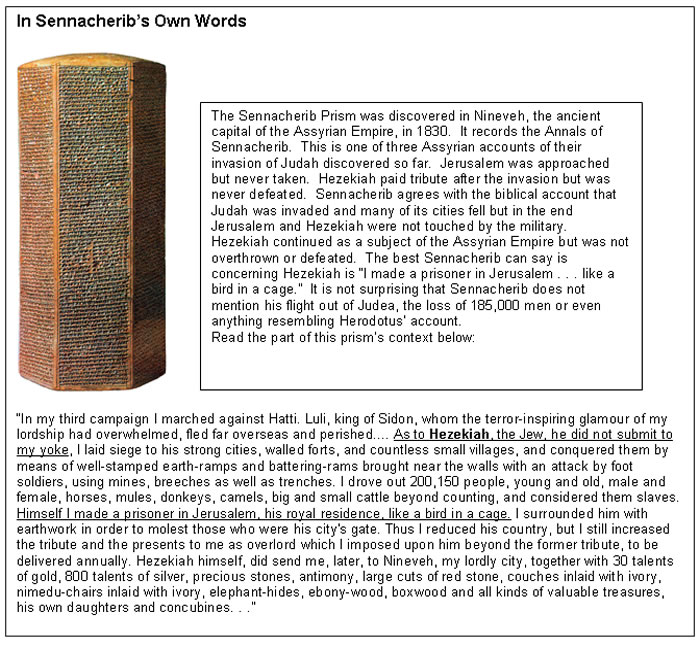
In response to the great influx of Israelites moving into Jerusalem after the Assyrian invasion of northern Israel (723-721) and in anticipation of an Assyrian invasion of Judea, Hezekiah had his men tunnel through the bed rock under the city of Jerusalem to redirect the water source on the east edge of the city to flow into the center of the expanded city west of the original City of David. “As for the other events of Hezekiah’s reign, all his achievements and how he made the pool and the tunnel by which he brought water into the city, are they not written in the book of the annals of the kings of Judah?” (2 Kings 20:20) In this photo Galyn walks through the tunnel that Hezekiah cut through the rock under Jerusalem.
|
|---|
Manasseh followed Hezekiah as king in 697 BC. Manasseh would rule for fifty-five years and may have led the most evil life of any king of Judah, but in the end he did repent. Manasseh rebuilt the high places his father Hezekiah had destroyed. Manasseh set up Baal altars and Asherah poles and even placed them in the temple in Jerusalem. He also offered his own son as a sacrifice in the fire. The prophets, including Isaiah, told him that he had gone beyond the wickedness of the Amorites who where driven out of the land before Israel. Tradition tells us that is was Manasseh who pursued Isaiah from Jerusalem towards Bethlehem (about 680) and had him sawn in half with a wooden saw once he was captured. God promised to bring disaster to Jerusalem and Judah because of this wickedness. Around the year 678 Assyrian records show that Manasseh, along with other kings controlled by Assyria, were ordered to appear in Nineveh to receive their orders concerning the supplies they were to provide for Esarhaddon’s new palace. An inscription of Esarhaddon says:
“At that time the older palace of Nineveh, which the kings who went before, my fathers, had built. . . had come to seem too small to me. . . .That small palace I tore down in its totality. . . .And I summoned the kings of Syria and those across the sea - Baalu, king of Tyre; Manasseh, king of Judah; Kaushgabri, king of Edom; Musurri, king of Moab. . .twenty kings in all. I gave them their orders.”
Ashurbanipal, kind of Assyria, faced a revolt by his brother Shamash-Shum-Ukin in Babylon in 652. After a three year siege of Babylon Ashurbanipal defeated his brother. It was at this time Manasseh was focibly taken out of Jerusalem by the Assyrians with a hook in his nose and in bronze shackles. Manasseh was taken as a prisoner to Babylon by Ashurbanipl. It appears Manasseh had either sided with Shamah-Shum-Ukin or was suspected of having supported the rebellion. While in prison Manasseh repented before the Lord and the Lord restored Manasseh to his throne in Jerusalem. For the remaining six years of his life Manasseh got rid of the foreign gods and removed the images from the temple. He restored the temple and temple services and told the people of Judah to seek the Lord. The people did not listen. Manasseh’s son Amon would have a short, evil reign for two years but this would be followed by Josiah who took the throne at the age of eight. Josiah would have been born the year his grandfather Manasseh returned from his Babylonian prison. Josiah’s first six years of his life would have been lived during King Manasseh’s six years as a believer who was trying to restore the proper worship of the Lord.
Amon was twenty-two when he became king but was assassinated in his palace by his officials after two evil years as king.
Josiah becomes king in 640 BC at the age of eight. When he was sixteen years old (632) he began to seek the Lord and then when he was twenty years old (628) he began to purge Judah and Jerusalem of high places and Asherah poles. When Josiah was twenty-six (622) he sent a team of men to repair the temple. While working in the temple the Book of the Law, or the writings of Moses, was discovered. After having read the covenant Israel had with the Lord Josiah, along with Jeremiah and others, realized they had failed for years to be obedient and they feared judgment was coming. Josiah and the prophets stepped up their attempts to bring revival to the land. With this the final days of Judah begin.
|
ASSYRIAN EMPIRE |
|
640 |
|
Josiah |
632 |
|
|
628 |
|
|
627 |
|
Jer. 1, 2, 3 Nabopolassar |
626 |
|
Assyria is |
625 |
|
|
624 |
|
Zephaniah |
623 |
|
Law Found in Huldah Jeremiah 3 – 6 Daniel |
622 |
|
Jeremiah 11-12 |
612 |
|
Ninevah Falls |
609 |
|
Nebuchadnezzar Assyria Falls Josiah Dies |
|
BABYLONIAN EMPIRE |
|
|
|
|
608 |
|
Jehoahaz, king of Judah Jehoiakim, king of Judah Jeremiah 22,26,27 |
606 |
|
Habakkuk |
605 |
|
Carchemish Egypt Defeated Nabopolassar Dies Nebuchadnezzar takes Daniel captive Nebuchadnezzar becomes king of Babylon |
604 |
|
Jeremiah 45-49, 35, 36, 25 Daniel Appears before Nebuchadnezzar Statue Dream – Gold, Silver, Bronze, Iron & Clay |
603 |
|
Jeremiah 13-20 |
602 |
|
|
601 |
|
Egypt driven out of Syria & Israel Babylon suffers heavy losses Jehoiakim Rebels |
|
|
|
600 |
|
Nebuchadnezzar Rebuilds |
599 |
|
Raiders Nebuchadnezzar Returns |
598 |
|
Jehoiakim Dies Jehoiachin becomes King |
597 |
|
Nebuchadnezzar arrives at Jerusalem Zedekiah becomes King Ezekiel Taken in Second Captivity Jeremiah Writes Captives Jeremiah 24, 29 |
596 |
|
Tyre Siege Begins |
594 |
|
Zedekiah Plans a Revolt False Prophets Hananiah Zedekiah Appears Before Babylon Prophecy Jeremiah 27, 28, 50, 51 |
593 |
|
Ezekiel See Vision Ezekiel 1-7 |
592 |
|
Ezekiel 8-10,12-19 |
591 |
|
Ezekiel 20-23 |
589 |
|
Zedekiah Revolts |
588 |
|
Ezekiel 24 |
587 |
|
Ezekiel 29 Babylon Fights Break in Siege Jeremiah 30, 31, 32, 33, 21, 38, 34 Jeremiah is in a dungeon, courtyard and a cistern |
586 |
|
Jerusalem’s Walls Fall July 18 Temple is Destroyed Jerusalem Burnt August 14 Jeremiah 39, 52 Nebuzar-Adan Jeremiah 40 Gedaliah Appointed Governor & is |
KEY POINTS (back to the top)
OTHER SITES (back to the top)
BOOKS from Galyn's Shelf: (back to the top)
QUESTIONS (back to the top)
TAKE THE TESTS
Chapter Tests:
Sect D, Ch 19 - Exodus through Solomon
Sect D, Ch 20 - Kings of Israel
Sect D, Ch 21 - Kings of Judah
Essay Tests:
Sect D, Ch 19 - Compare and Contrast the Tabernacle with the Temple
Sect D, Ch 20 - Provide Historical Evidence of Israel & Judah's Interaction with Nations
Sect D, Ch 21 - Hezekiah's Tunnel